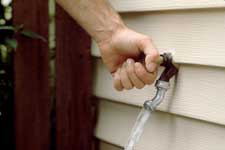- Landfills Home
- Bioreactors
- Publications
- Regulations
- Groundwater Monitoring
- Closure / Post-Closure
- Financial Assurance
Groundwater Monitoring Requirements for Municipal Solid Waste Landfills (MSWFs)

Nearly all municipal solid waste landfills (MSWLFs) are required to monitor the underlying groundwater for contamination during their active life and post-closure care period. The exceptions to this requirement are small landfills that receive less than 20 tons of solid waste per day, and facilities that can demonstrate that there is no potential for the migration of hazardous constituents from the unit into the groundwater. All other MSWLFs must comply with the groundwater monitoring requirements found at 40 CFR Part 258, Subpart E–Ground-Water Monitoring and Corrective Action.
To monitor groundwater, facility owners and operators must install a groundwater monitoring system that can collect samples from the uppermost aquifer (defined as the geological formation nearest the natural surface that is capable of yielding significant quantities of groundwater to wells or springs). The groundwater monitoring system consists of a series of wells placed upgradient and downgradient of the MSWLF. The samples from the upgradient wells show the background concentrations of constituents in the groundwater, while the downgradient wells show the extent of groundwater contamination caused by the MSWLF. The required number of wells, spacing, and depth of wells is determined on a site-specific basis based on the aquifer thickness, groundwater flow rate and direction, and the other geologic and hydrogeologic characteristics of the site. All groundwater monitoring systems must be certified by a qualified groundwater scientist and must comply with the sampling and analytical procedures outlined in the regulations. For more information, see the Resources section below.
There are three phases of the groundwater monitoring requirements:
Detection Monitoring
During the detection monitoring phase, MSWLF owner/operators monitor for the 62 constituents listed in Appendix I of 40 CFR Part 258. This consists of sampling at least semiannually throughout the facility's active life and post-closure care period. The frequency of sampling is determined on a site-specific basis by the state regulatory agency.
If at any time during the detection monitoring phase, one of the 62 constituents is detected at a statistically significant higher level than the established background level, the MSWLF owner/operators must notify the state regulatory agency. The facility must establish an assessment monitoring program within 90 days unless the owner/operators can prove that the detection of the constituent(s) was the result of a sampling, analysis, or statistical evaluation error (i.e., a false positive result); a natural fluctuation in groundwater quality; or caused by another source.
Assessment Monitoring
Within 90 days of detecting a statistically significant increase in the constituents listed in Appendix I constituents, a MSWLF must begin an assessment monitoring program. As a first step, samples must be taken from all wells and analyzed for the presence of all 214 constituents listed in Appendix II of 40 CFR Part 258. If any of the constituents listed in Appendix II are detected, the owner/operators must then establish the background levels for these constituents and establish a groundwater protection standard (GWPS) for each. The GWPS represents the maximum allowable constituent level in the groundwater, and is based either on the Safe Drinking Water Act (SDWA) Maximum Contaminant Level (MCL) for that constituent, or the background level of the groundwater at the site if no MCL exists. In cases where the site-specific background level is higher than the MCL, the background level is used for the GWPS.
Within 90 days of establishing the background levels and the GWPS, the owner/operators must then resample for all constituents listed in Appendix I and Appendix II previously detected. Resampling then must be repeated at least semiannually. If none of the Appendix II constituents are found to exceed the GWPS for two consecutive sampling events, the facility may return to the detection monitoring phase. If, however, any of the constituents are detected at a statistically significant level higher than the GWPS, the owner/operators of the MSWLF must characterize the nature of the release, determine if the contamination has migrated beyond the facility boundary, and begin assessing corrective measures.
Corrective Action
Based upon the assessment of corrective measures, a remedy is selected and corrective action begins. Any corrective measure selected must be protective of human health and the environment, meet the GWPS, control the source(s) of the release to prevent further releases, and manage any solid waste generated in accordance with all applicable RCRA regulations. The facility must continue these remedial actions until it has complied with the GWPS for three consecutive years and can demonstrate that all required actions have been completed.
Resources
Municipal Solid Waste Landfill Criteria–Technical Manual: Chapter 5, Subpart E–Ground-Water Monitoring and Corrective Action (PDF) (114 pp, 656 K, about PDF) This 1993 manual is a companion to the Municipal Solid Waste Landfills Criteria promulgated on October 9, 1991 as 40 CFR Part 258. Chapter 5 provides owners/operators with guidance for complying with the groundwater monitoring and corrective action MSWLF Criteria.
RCRA Training Module Introduction to Municipal Solid Waste Disposal Facility Criteria (PDF) (27 pp, 123 K, about PDF) Introduces all of the design and operation criteria for MSWLFs, including details on the groundwater monitoring requirements.
RCRA Online Database Indexes thousands of letters, memoranda, publications, and questions and answers issued by EPA's Office of Resource Conservation and Recovery (ORCR). These documents represent EPA Headquarters interpretations of the RCRA regulations governing the management of solid, hazardous, and medical waste.
RCRA FAQ Database Enables users to search frequently asked questions, or submit their own question/comment on a variety of RCRA issues and topics.
![[logo] US EPA](../gif/logo_epaseal.gif)